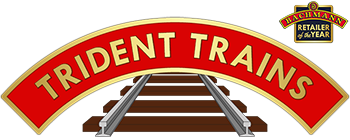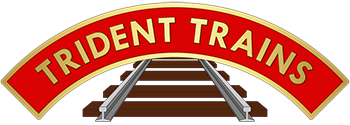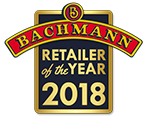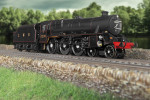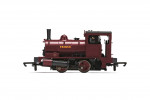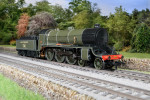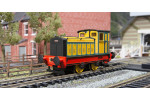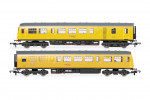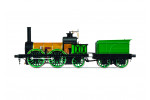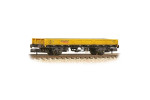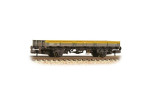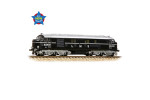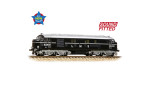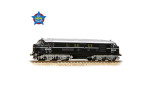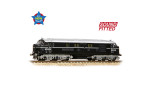Search results
 R30224
R30224LMS, Stanier 5MT 'Black 5', 4-6-0, 5200
The ‘Black 5s', were a mixed traffic locomotive, a ‘do-anything go-anywhere’ type, designed by Stanier and introduced in 1934. In their early days the locomotives were known as the ‘Black Staniers’ because of their black livery, but were later nicknamed ‘Black 5s'. Known for a truly staggering number of potential modifications, the Black 5 was the workhorse of the LMS and later BR from 1934 -1951.
 R30287
R30287United Glass Bottle Manufacturing Ltd, Pug, 0-4-0, No. 19 'Prince'
The diminutive Pug locomotive had its basis in the pre-grouping Lancashire and Yorkshire Railway, with the locomotives being built in batches by their designer John Aspinall, his successor Henry Hoy and his successor George Hughes.
The locomotives were designed as shunters for the northern region. Their small wheels and wheelbase made them ideal to negotiate the tight trackwork that is often found around docks and such. When the grouping act came into effect the locomotives were given the somewhat taunting power classification of 0F, such was their size and the specificity of their use.
Locomotive 19 was built in the 1910 batch, the last such batch of the class built. After its career with the L&YR and then LMS the locomotive was sold to the Mowlem and Co civil engineering company and then to the United Glass Bottle Manufacturers.
There it was bestowed with the name Prince and an attractive marron livery. The locomotive is now preserved, with a fire lit under the boiler in February 2022 being the first since the early 1970s.
 R30273
R30273SR, N15 'King Arthur Class', 4-6-0, 741 'Joyous Gard': Big Four Centenary Collection
The N15 Class, introduced in 1918 from a design by Robert Urie, was also known as the King Arthur Class, being named after persons and places associated with the legend of King Arthur and the Round Table. This class of two cylinder 4-6-0 passenger steam locomotives proved to be one of the most successful during the post-grouping era of 1928-1948, with 74 locomotives being built during this time.
The whole class was built in a total of six batches, with the first two batches being built at the London & South Western Railway's Eastleigh Works between 1918-19 and 1922-23. Carrying the characteristics of Urie's stove pipe chimney, Drummond style of cab and inspired by the shape of the H15, the first batches of locomotives became known as 'Urie Arthurs'.
Upon assuming the position of CME of the Southern Railway, Richard Maunsell built a third batch of ten locomotives at the Eastleigh Works and these became known as the 'Eastleigh Arthurs'. Maunsell's batch incorporated a small number of significant modifications including changes in the draft, valve gear, chimney, blastpipe and an overall increase in boiler pressure that significantly improved the performance.
In 1924 two more batches were ordered from the Scottish based North British Locomotive Company. These 30 locomotives, referred to as 'Scottish Arthurs' were built to the Southern Railways new composite loading gauge and were connected to eight wheel bogie tenders, which had a 5,000 imperial gallon capacity.
The last batch of 15 locomotives were built at Eastleigh between 1926-27 and adopted a six wheel 3,500 imperial gallon tender. Despite the order the batch was never completed, with the last locomotive being replaced by the prototype of the Lord Nelson Class of locomotives. Having proved to be one of the greatest designs of its day, the King Arthur Class combined reliability with impressive performance.
The introduction of electrification, plus the Lord Nelson Class and ultimately, the Bulleid Pacific locomotives, all hastened the N15's departure.'Joyous Gard' was the sixth example of the class to be built, numbered 741 it would leave the shed at Eastleigh in April 1919. During its life the locomotive would receive various modifications such as the class wide installation of smoke deflectors as well as being fitted with a Lemaitre exhaust, becoming one of only five of the class to have the upgrade fitted.
The locomotive would become 30741 under British Railways, before being withdrawn and scrapped in February 1956. Only one member of the class would be preserved, a North British Loco built example, 777 Sir Lamiel, part of the National Collection, under the care of the 5305 Locomotive Association, being based at the Great Central Railway in Leicestershire.
 R3894
R3894North British Distillery Co. Ltd, Ruston & Hornsby 88DS, 0-4-0, No. 4
Ruston & Hornsby Ltd, of Lincoln, was formed as the result of the merger between Ruston, Proctor & Co. Ltd and Richard Hornsby & Sons Ltd on September 11, 1918 and their first narrow gauge diesel locomotive left the works on September 1, 1931. In the summer of 1932, production was moved to the larger Boultham Works, where the firm were eventually to become Britain's largest builder of diesel locomotives, with over 6,500 being built by the time production ceased in 1969. Almost as soon as the firm's 44/48HP 0-4-0 locomotives were making an appearance, an upgraded, more powerful 0-4-0 was on the drawing board.
Although many of the features of the 44/48HP were retained for the new 80/88HP, such as the chain drive and running gear, a new type of transmission was fitted, along with Westinghouse airbrakes. The new power unit, Ruston's own 4VPB, delivered 80BHP at 1000rpm and was later supplanted by Ruston's improved 4VPH that delivered 88BHP, but it required compressed air to be injected into the cylinders to be able to start. While running, an air reservoir was kept charged via the braking system, but after standing idle for a period the reservoir depleted and a secondary source was required to recharge the reservoir. This was achieved by fitting a small, secondary 1½HP 'donkey' engine, giving rise to a distinctive raised cover on the right hand side of the engine compartment that differed in size and placement depending on the make of engine used. Two basic weight options were offered for the 80/88HP, of 17 tons and 20 tons, the difference being achieved by attaching weights to the outside frames, as well as to the front and rear buffer beams.
In 1941, Ruston's locomotive classifications were changed, with the 80/88HP becoming 88DS (with the narrow gauge versions being assigned the DSM and DSN suffix, and the broader gauges assigned DSW). Outward appearance changes to the 'standard' locomotives were mainly confined to the cab area, with examples from mid-1947 replacing the open cab with a fully enclosed cab that featured several ad-hoc styles of front window. The final 88DS, 518494, left Boultham Works on 29 November 1967, bringing to an end a production run of 271 locomotives.
Ruston 421415 was built new for the North British Distillery Co. Ltd, being delivered in March 1958 to their distillery in the Gorgie district of Edinburgh, around the period when the distillery was expanding to include the former Edinburgh Corporation Tramways depot. In 1973, the locomotive was donated to the fledgling Fife Railway Preservation Group, who located it at the Lochty Private Railway until its demise in 1994. 421415, now numbered NBD No. 4, has now been restored and wears the livery of the North British Railway.
 R30195
R30195RailRoad Plus Network Rail, Class 960, Bo-Bo, 901002 'Iris 2'
Constructed in Birmingham, the Class 101 DMU was one of the longest lasting DMUs to ever see service in the UK. 527 of the class would be built across many orders from BR between 1956 and 1960. The first units would enter BR service in 1956 in the BR green livery.
Class 101 units at the height of their use could be seen in all corners of the UK, at the onset of privatisation in the 1990s the units would appear in all manner of colourful liveries such as the Network South East colours and First North Western. Throughout their life, Class 101 units would occasionally appear as a three car sets where demand dictated.
Beginning life as the BR Class 101 unit 50338 On its entry into departmental service the unit would be reclassified as a class 960 and renumbered 901002, it would also gain the name Iris 2 which would be displayed in place of a destination on its destination boards.
Iris 2 functioned as a lab for Network Rail undertaking tests around the UK. As Iris 2, the DMU appeared in a Serco Railtrack livery, Network Rail livery and a unique grey Lab 19 livery. Iris 2 is currently preserved on the Barry Tourist Railway in a BR Green livery.
 R30348
R30348L&MR, No. 58 'Tiger'
Number 58 'Tiger' was the sister engine to 'Lion', one of a plethora of locomotives named after animals as became the norm for the fledgling L&MR. Like its sister engine, 'Tiger' was designed as a luggage engine and was delivered from Todd, Kitson, and Laird alongside 'Lion', having been constructed at the same time as part of the same order. These were the first two locomotives to be built at the Railway Foundry in Leeds.
Information regarding 'Tiger' is scant, but as it was built to the same specifications, it is a reasonable assumption that the engine would have served the same duties as its more notable sister. It is also likely that the engine was also rebuilt at Edge Hill in 1841.
Likely still in service when the L&MR was absorbed into Grand Junction Railway and then the London and North Western Railway, 'Tiger' would have also been renumbered under its new operator. As it is not in preservation, it is assumed that at the time 'Lion' was withdrawn and converted into a stationary pump, 'Tiger' was also withdrawn and scrapped.
 377-731A
377-731ABR SPA Open Wagon Network Rail Yellow [W]
 377-730B
377-730BBR ZAA 'Pike' Open Wagon BR Engineers Grey & Yellow [W]
 372-910
372-910LMS 10000 LMS Black & Silver
The LMS ‘Twins’ – Nos. 10000 and 10001 – were the very first mainline diesel locomotives built in the UK and now, this pioneering pair is available in N scale for the first time thanks to Graham Farish.
This model of No. 10000 depicts the first of the ‘Twins’ which entered service with the LMS just days before Nationalisation in December 1947, and so carries ‘LMS’ in large chrome letters on the bodyside – the locomotive would carry these during its early years of BR-ownership and was so adorned until 1951. In this original condition, No. 10000 operated on the Midland Region hauling trains both alone and as a pair with its twin, providing additional haulage power and rang
 372-910SF
372-910SFLMS 10000 LMS Black & Silver With DCC Sound Fitted
The LMS ‘Twins’ Nos. 10000 and 10001 were the first mainline diesel locomotives built in Great Britain. A joint venture between the London, Midland & Scottish Railway (LMS) and English Electric, the pair were first conceived in 1946. The body and chassis design was undertaken by the LMS’s Chief Mechanical Engineer H. G. Ivatt, and English Electric provided the engine, electric systems and machinery. Construction of No. 10000 began at Derby Works in 1947 and the locomotive was outshopped in December of that year, days before Nationalisation of Britain’s railways.
Both locomotives entered traffic in an eye-catching black and silver livery, with large chrome numbers fitted at each end of the bodysides, below the cab windows. The letters LMS were also applied in chrome to No. 10000, however No. 10001 did not enter service until mid-1948, with British Railways completing its construction, and so it entered traffic with neither LMS nor BR markings.
The locomotives worked both singularly and as a pair on the Midland Main Line and West Coast Main Line, hauling named expresses and lower key services, and venturing north of the border into Scotland. Interconnecting doors were fitted within the noses of each engine, allowing crew and personnel to move between the two in motion, but this feature was seldom used.
In 1953 the Twins were sent to the Southern Region, being fitted with an additional pair of marker lights and lamp brackets beforehand which made them compatible with the SR’s practice of using headcodes to denote both train types and routes. During a two year period on the Southern Region the Twins worked alongside the Southern’s own diesel prototypes before returning to the Midland Region in 1955.
As prototypes, changes and modifications were made to the locomotives during the years and this included the fitting of water scoops to allow water for the steam heat boiler to be collected from troughs located between the rails ‘on the move’. Ironically, in common with many early diesels, the performance of the steam heat boilers was woeful, and in colder months the pair were often relegated to freight workings where steam heat provision was not required.
By the late-1950s new, production series diesel locomotives were arriving en-masse and whilst their time in service had been highly educational and helped to shape the BR diesel fleet, the writing was on the wall for this pair on non-standard prototypes. No. 10000 was officially withdrawn in December 1963, whilst No. 10001 lasted to March 1966, kept going with components salvaged from its Twin. Sadly, neither was saved and both were subsequently scrapped, but their legacy carried on in the Class 40s, 50s and 56s which all used versions of the English Electric 16SVT engine and today, works is ongoing to build a replica of No. 10000.
 372-911
372-911LMS/BR 10001 Black & Silver
The LMS ‘Twins’ Nos. 10000 and 10001 were the first mainline diesel locomotives built in Great Britain. A joint venture between the London, Midland & Scottish Railway (LMS) and English Electric, the pair were first conceived in 1946. The body and chassis design was undertaken by the LMS’s Chief Mechanical Engineer H. G. Ivatt, and English Electric provided the engine, electric systems and machinery. Construction of No. 10000 began at Derby Works in 1947 and the locomotive was outshopped in December of that year, days before Nationalisation of Britain’s railways.
Both locomotives entered traffic in an eye-catching black and silver livery, with large chrome numbers fitted at each end of the bodysides, below the cab windows. The letters LMS were also applied in chrome to No. 10000, however No. 10001 did not enter service until mid-1948, with British Railways completing its construction, and so it entered traffic with neither LMS nor BR markings.
The locomotives worked both singularly and as a pair on the Midland Main Line and West Coast Main Line, hauling named expresses and lower key services, and venturing north of the border into Scotland. Interconnecting doors were fitted within the noses of each engine, allowing crew and personnel to move between the two in motion, but this feature was seldom used.
In 1953 the Twins were sent to the Southern Region, being fitted with an additional pair of marker lights and lamp brackets beforehand which made them compatible with the SR’s practice of using headcodes to denote both train types and routes. During a two year period on the Southern Region the Twins worked alongside the Southern’s own diesel prototypes before returning to the Midland Region in 1955.
As prototypes, changes and modifications were made to the locomotives during the years and this included the fitting of water scoops to allow water for the steam heat boiler to be collected from troughs located between the rails ‘on the move’. Ironically, in common with many early diesels, the performance of the steam heat boilers was woeful, and in colder months the pair were often relegated to freight workings where steam heat provision was not required.
By the late-1950s new, production series diesel locomotives were arriving en-masse and whilst their time in service had been highly educational and helped to shape the BR diesel fleet, the writing was on the wall for this pair on non-standard prototypes. No. 10000 was officially withdrawn in December 1963, whilst No. 10001 lasted to March 1966, kept going with components salvaged from its Twin. Sadly, neither was saved and both were subsequently scrapped, but their legacy carried on in the Class 40s, 50s and 56s which all used versions of the English Electric 16SVT engine and today, works is ongoing to build a replica of No. 10000.
 372-911SF
372-911SFLMS/BR 10001 Black & Silver With DCC Sound Fitted
The LMS ‘Twins’ Nos. 10000 and 10001 were the first mainline diesel locomotives built in Great Britain. A joint venture between the London, Midland & Scottish Railway (LMS) and English Electric, the pair were first conceived in 1946. The body and chassis design was undertaken by the LMS’s Chief Mechanical Engineer H. G. Ivatt, and English Electric provided the engine, electric systems and machinery. Construction of No. 10000 began at Derby Works in 1947 and the locomotive was outshopped in December of that year, days before Nationalisation of Britain’s railways.
Both locomotives entered traffic in an eye-catching black and silver livery, with large chrome numbers fitted at each end of the bodysides, below the cab windows. The letters LMS were also applied in chrome to No. 10000, however No. 10001 did not enter service until mid-1948, with British Railways completing its construction, and so it entered traffic with neither LMS nor BR markings.
The locomotives worked both singularly and as a pair on the Midland Main Line and West Coast Main Line, hauling named expresses and lower key services, and venturing north of the border into Scotland. Interconnecting doors were fitted within the noses of each engine, allowing crew and personnel to move between the two in motion, but this feature was seldom used.
In 1953 the Twins were sent to the Southern Region, being fitted with an additional pair of marker lights and lamp brackets beforehand which made them compatible with the SR’s practice of using headcodes to denote both train types and routes. During a two year period on the Southern Region the Twins worked alongside the Southern’s own diesel prototypes before returning to the Midland Region in 1955.
As prototypes, changes and modifications were made to the locomotives during the years and this included the fitting of water scoops to allow water for the steam heat boiler to be collected from troughs located between the rails ‘on the move’. Ironically, in common with many early diesels, the performance of the steam heat boilers was woeful, and in colder months the pair were often relegated to freight workings where steam heat provision was not required.
By the late-1950s new, production series diesel locomotives were arriving en-masse and whilst their time in service had been highly educational and helped to shape the BR diesel fleet, the writing was on the wall for this pair on non-standard prototypes. No. 10000 was officially withdrawn in December 1963, whilst No. 10001 lasted to March 1966, kept going with components salvaged from its Twin. Sadly, neither was saved and both were subsequently scrapped, but their legacy carried on in the Class 40s, 50s and 56s which all used versions of the English Electric 16SVT engine and today, works is ongoing to build a replica of No. 10000.
